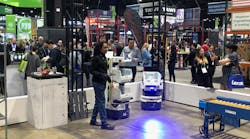By Chris McNamara, Smart Industry editor in chief
For all of the robotic wonders on display throughout the miles of aisles at the ProMat 2023 event this week in Chicago, the focus for the vendors, the solution-providers, the manufacturers and the distribution-center personnel in attendance was decidedly human.
In a nutshell, everybody at this manufacturing and supply chain mega-event was looking to make their humans work more efficiently. Now, of course, the tools to enable those efficiencies often look like they’re straight out of a sci-fi movie:
Walking robots with glowing eyes athletically lugging crates from one shelf to another (all while spectators gawk and snap photos of the scene like paparazzi).
Conveyer belts with the smarts to sort packages and zip them into the correct bin in the blink of an eye.
Smart forklifts that are nimble enough, it seems, to perform cosmetic surgery.
It’s amazing stuff. And when you speak to the reps at each of these stations, they echo that same message—we’re here trying to empower the human workers to work smarter.
For Laura Hoffman, with Zebra Technologies robotics division, solutions include a small computer worn on the back of the hand with a voice-control system enabling the operator to speak with nimble autonomous robotic vehicles that buzzed around our ankles while we chatted. (These robot makers love to highlight the smart, safe interactions that workers enjoy with their metallic counterparts.)
For Bradford Blair with ServiceNow, working better means sharper management of assets to reduce redundant, unnecessary processes by relying on greater visibility for field-service techs. This week he was sharing with ProMat attendees what he described as a “meat and potatoes” use case for monitoring machines.
“We’re all about helping workers do their jobs safer and better,” explained Lucas Systems’ Ken Ramoutar, where they are trying to fill holes left by gaps in the workforce caused by the pandemic, the retirement of seasoned distribution-center personnel, misconceptions about manufacturing jobs, etc. Compounding those workforce challenges for many in the distribution space is increased customer demand for faster, most customized products.
More needs to be accomplished with fewer people to do it. If you can’t build more facilities and staff them with larger workforces, you simply have to work more efficiently if you’re going to capitalize on this moment in time.
As Ramoutar explained, “The big question is ‘How do I get more done?’”
Here at ProMat, there were thousands of answers.


